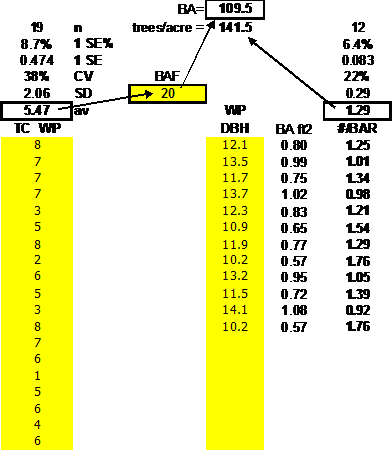Questions from the Field:
Isn’t the number of trees quite variable with VP sampling?
There is an easy way to compute this with your own data. Get some of the diameters from one of your cruises. It could be a Big BAF cruise, a measure/count set of plots or any other method you use. The method does not matter at all, as long as the trees were selected with an angle gauge like a prism or Relascope.
For each tree, compute the “#BAR” : the number of trees per square foot of basal area. This is easy. Just divide 1.0 (this means one tree) by the basal area of that tree. The example EXCEL program below shows how to do this.
This is an actual example from a set of White Pines in Maine. The CV of the #BAR can be compared to the CV of the tree count to plan how many trees should be measured per sample point. As you can see here, the number of trees per square foot is a lot less variable than the number of square feet per acre.
Similar to other computations, it is [BA/acre * #BAR] that gives the total number of trees per acre. You need to have good answers for each of these items. In this case, the results indicate that you need to measure about 22 trees for every 38 tree counts (based on the two CV’s). Check out the results from your own area and see how they compare.
You can also use the standard “stand table factor” approach, but this method shows how the process is related to any other calculations you might do in Variable Plot Sampling, and gives a simple indication of what proportion of trees need diameter measurements in order to get “good” answers for trees/acre.
Originally published November, 2008
